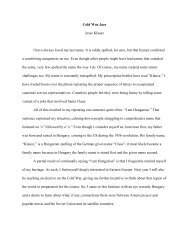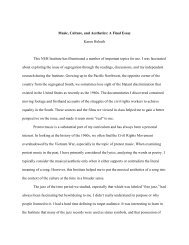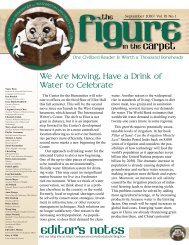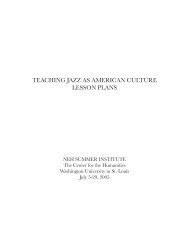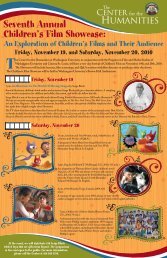You also want an ePaper? Increase the reach of your titles
YUMPU automatically turns print PDFs into web optimized ePapers that Google loves.
128Mike CaddenSpeaking to Both Children <strong>and</strong> Genre:Le Guin’s Ethics of AudienceMike Cadden<strong>The</strong>re are precisely as many genres as we need, genres whose conceptualshape is precisely determined by that need.(Adena Rosmarin)Writers who claim that <strong>the</strong>y write only for <strong>the</strong>mselves deny that <strong>the</strong>influence of ei<strong>the</strong>r genre or a readership guides <strong>the</strong> writing. <strong>The</strong>se writersargue by implication that <strong>the</strong>y nei<strong>the</strong>r communicate with readers norobserve generic traditions; <strong>the</strong>y simply write to <strong>the</strong>mselves. <strong>The</strong>y are selfproclaimedliterary isolationists. Jill Paton Walsh (“<strong>The</strong> Writers in <strong>the</strong>Writer” 4), Ka<strong>the</strong>rine Paterson (47, 50), P. L. Travers (63), Mollie Hunter(12), <strong>and</strong> Michael Steig (Bottner 4) all directly point to <strong>the</strong>mselves as atleast partial audience in <strong>the</strong>ir commentaries on writing for children, but<strong>the</strong>y don’t go so far as to claim that <strong>the</strong>y don’t write for children. ArthurRansome made “<strong>the</strong> reiterated denial that he wrote for children” (Wall30), but he ultimately “made a distinction between writing for children<strong>and</strong> writing to children” (30), claiming <strong>the</strong> latter occupation for himself.Peter Hollindale believes that Ransome is less interested in child readersthan he is childhood (“Signs” 31), which Hollindale considers a feature of<strong>the</strong> genre of children’s literature. In any case, writers for children whowould deny both interest in <strong>and</strong> consciousness of form <strong>and</strong> audienceargue that <strong>the</strong>irs is children’s literature entirely by accident. However, abook becomes a children’s book—intended by <strong>the</strong> writer or not—whencritics identify generic features (text) <strong>and</strong>/or children find that <strong>the</strong> bookspeaks to <strong>the</strong>m (context).I’m more interested in <strong>the</strong> children’s writer who claims both to writechildren’s books <strong>and</strong> to write books for children—those writers whoconflate text <strong>and</strong> context. When <strong>the</strong> children’s author describes “writing<strong>The</strong> <strong>Lion</strong> <strong>and</strong> <strong>The</strong> <strong>Unicorn</strong> <strong>24</strong> (2000) 128–142 © 2000 by <strong>The</strong> Johns Hopkins University Press



